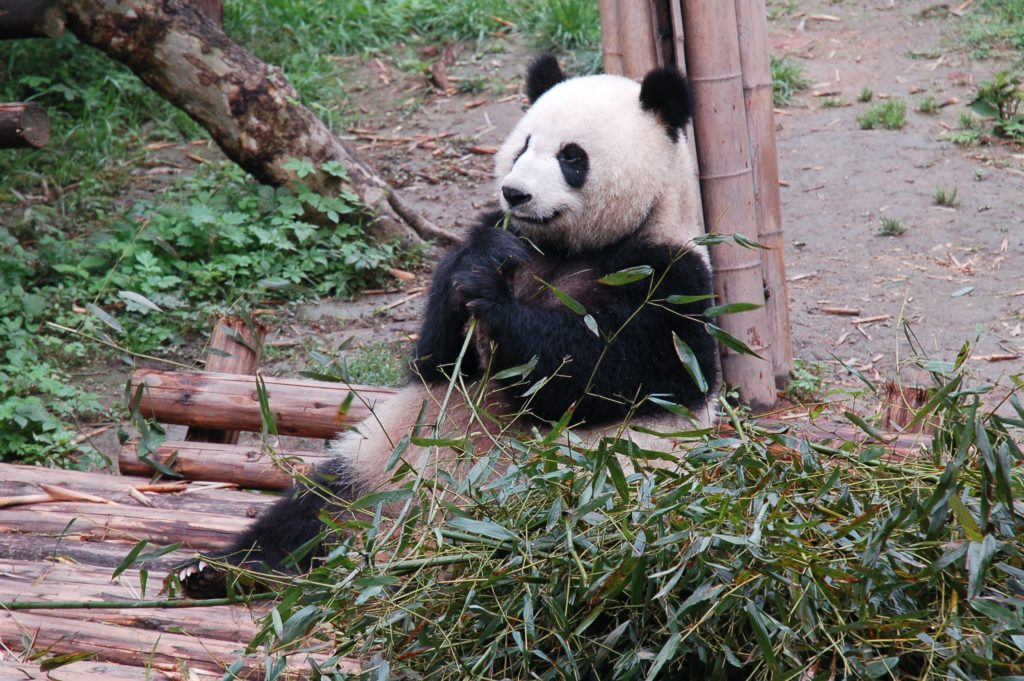
I learned this today. Pandas eat bamboo because it is such an abundant food source that they don’t need to fight over food or search for it.
There is some argument over when pandas started eating bamboo. The general consensus is that they began to eat bamboo about 6 million years ago. Evidence for this is the evolution of their false thumb. This is a sixth digit that protrudes just under the panda’s real thumb, jutting out from the wrist. It is short and its only purpose is to balance the bamboo that the panda is eating. It has to be short because pandas walk on all four legs and if it was any longer it would interfere with their walking.
However, a recent study has suggested that pandas only made the switch to bamboo about 5000 years ago. This study looked at the isotopes in the bodies of pandas that died thousands of years ago and of those that died more recently. The isotopes from the older pandas were significantly different, which shows that pandas thousands of years ago had a more varied diet. The study doesn’t claim that pandas only started to eat bamboo recently, just that they ate other things as well until relatively recently.
Panda should not be able to eat bamboo. They have to make substantial changes to their life in order to be able to survive on it. Pandas have the intestines of carnivores because they are bears and bears are generally carnivores. This means their intestines are far shorter than those of a herbivore. Cellulose in plants is very difficult to break down, so herbivores generally have more than one stomach and a long intestine to give the plant matter plenty of time to break down. Pandas don’t have that. This means, in order to get all of the calories that they need, they have to eat about 30kg of bamboo a day. They also move as little as possible to conserve energy.
When pandas evolved to start eating bamboo they went through a few changes. The first was the growth of the false thumb which helps them balance and eat the bamboo. The second was the loss of the umami taste receptor. Most carnivores have an umami taste receptor so that they enjoy the taste of meat. Panda gradually lost this, starting about 6 million years ago. Their jaws became stronger so they could chew the bamboo and their teeth became harder. The enamel on their teeth constantly regrows because bamboo is very abrasive. Their teeth became rounder, more useful for chewing than for ripping.
They also evolved to absorb more protein than most other animals. Pandas eat about half of their calories as protein and the rest from fat and carbohydrates. When scientists analyzed the panda’s manure they expected to see a lot of the protein in it because most animals can’t absorb that much protein. However, the amount of protein was very low, which means they were digesting nearly all of it.
Because pandas rely so heavily on protein, they have to find it. Bamboo grows extremely quickly and as it grows the ratio of protein to fiber changes quickly. Young bamboo has a very high amount of fiber. To take advantage of this, pandas move around the areas they live in as the growing seasons change. They eat the young bamboo at the bottom of the mountains when it starts growing. Once it is too big to give them enough protein, they gradually move up the mountain, eating the young shoots. Once they get to the highest point they can and there are no more young shoots, they move to eating bamboo leaves, which still have more protein than the grown stalks. At the end of the season, they move back to the bottom and start again.
So, why did pandas start eating bamboo? Well, no one seems to know is the honest answer. However, if a carnivore is going to switch to eating a plant, then bamboo is one of the best choices they could make. It is higher in starch and protein than any other woody plant. It is abundant and it grows extremely quickly. There is no danger that it will run out. With most animal species, their populations rise and fall with the amount of available food. If there is no danger of a food shortage, the population of pandas will never decline and that could have had an evolutionary advantage. The great amount of available food also means that they don’t have to fight over food sources, which is probably good from an evolutionary point of view. There can be no use to the overall population if individual members are trying to kill each other. They also don’t have to move much, which, again, could be a good thing.
So, pandas had to evolve a number of changes to be able to survive on bamboo. Why they did so is not fully known. And this is what I learned today.
Photo by Brian Petty: https://www.pexels.com/photo/panda-eating-green-bamboo-leaves-7571168/
Sources:
https://news.cgtn.com/news/3d3d514d7a6b544d33457a6333566d54/index.html
https://www.nature.com/articles/d41586-019-00301-y
https://www.latimes.com/science/la-sci-panda-diet-bamboo-protein-carnivore-20190503-story.html
